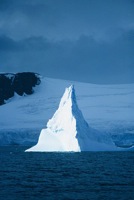Iceberg
Origin
probably part translation of Dan or Norwegian isberg, from is ice + berg mountain
Definitions
- 1: a large floating mass of ice detached from a glacier
Description
An iceberg is a large piece of freshwater ice that has broken off a glacier or an ice shelf and is floating freely in open water. It may subsequently become frozen into pack ice (one form of sea ice). As it drifts into shallower waters, it may come into contact with the seabed, a process referred to as seabed gouging by ice.
Because the density of pure ice is about 920 kg/m³, and that of sea water about 1025 kg/m³, typically only one-tenth of the volume of an iceberg is above water. The shape of the underwater portion can be difficult to judge by looking at the portion above the surface. This has led to the expression "tip of the iceberg", for a problem or difficulty that is only a small manifestation of a larger problem.
Icebergs generally range from 1 to 75 metres (3.3 to 246.1 ft) above sea level and weigh 100,000 to 200,000 metric tons (110,000 to 220,000 short tons). The largest known iceberg in the North Atlantic was 168 metres (551 ft) above sea level, reported by the USCG icebreaker East Wind in 1958, making it the height of a 55-story building. These icebergs originate from the glaciers of western Greenland and may have an interior temperature of −15 to −20 °C (5 to −4 °F).[4]
Though usually confined by winds and currents to move close to the coast, the largest icebergs recorded have been calved, or broken off, from the Ross Ice Shelf of Antarctica. Iceberg B-15, photographed by satellite in 2000, measured 295 by 37 kilometres (183 by 23 mi), with a surface area of 11,000 square kilometres (4,200 sq mi). The largest iceberg on record was an Antarctic tabular iceberg of over 31,000 square kilometres (12,000 sq mi) [335 by 97 kilometres (208 by 60 mi)] sighted 150 miles (240 km) west of Scott Island, in the South Pacific Ocean, by the USS Glacier on November 12, 1956. This iceberg was larger than Belgium.
When a piece of iceberg ice melts, it makes a fizzing sound called "Bergie Seltzer". This sound is made when the water-ice interface reaches compressed air bubbles trapped in the ice. As this happens, each bubble bursts, making a 'popping' sound. The bubbles contain air trapped in snow layers very early in the history of the ice, that eventually got buried to a given depth (up to several kilometers) and pressurized as it transformed into firn then to glacial ice.
